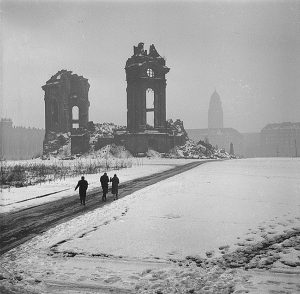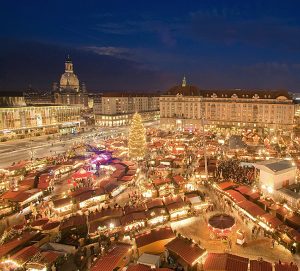Home »

Dresden Cathedral rose from the ashes
By Elinor Florence

I’ve been saving this subject for the Christmas season because it is so inspirational. The rebuilding of the bombed-out Church of Our Lady in Dresden, Germany, is a wonderful story of renewal and redemption.
I don’t want to discuss the controversy surrounding the bombing of Dresden, Germany, which took place near the end of the Second World War. To this day some experts feel that it was entirely justified, while others (including Winston Churchill) later expressed their doubts.
But just to give you a little background about this terrible event: Dresden is the baroque capital of Europe, a cultural landmark on the banks of the Elbe River in eastern Germany. It is sometimes called the ‘Florence of the Elbe.’
The British Royal Air Force and the U.S. Air Force carried out four bombing raids on Dresden between February 13 and 15 in 1945.
The exploding bombs and resulting firestorm flattened 1,600-square acres in the city centre, and killed 25,000 to 35,000 people.
Precise figures are impossible due to the huge number of refugees who fled into Dresden to escape the advancing Russian Army. The city lacked anti-aircraft guns and was virtually defenseless.
 In the lead image shown above, this statue on top of city hall overlooking the ruined city became one of the iconic photos of the Second World War. (Photo Credit: Richard Peter; Getty Images).
In the lead image shown above, this statue on top of city hall overlooking the ruined city became one of the iconic photos of the Second World War. (Photo Credit: Richard Peter; Getty Images).
There were too many bodies to bury, so the remains were stacked up in the Old Market Square in the city centre, and cremated.
The landmark church in the centre of Dresden, one that could be seen for many miles around, was a baroque-style Lutheran church named Frauenkirche, or Church of Our Lady, completed in 1744.
 Here’s a photo of the church in 1890. It’s already 150 years old in this photo!
Here’s a photo of the church in 1890. It’s already 150 years old in this photo!
In 1945, the Church of Our Lady withstood two days and two nights of attacks before surrendering to the bombs. The heat generated by 650,000 incendiary bombs set the city centre aflame and caused the supporting pillars to glow bright red.
At 10 a.m. on February 15, the pillars finally gave way, and 6,000 tons of stone collapsed into rubble (pictured below right).
Less than three months later, Germany surrendered. As part of the Allied settlement, the country was divided into two parts.
 Since Dresden was situated in East Germany, it fell under the control of the Soviet Union.
Since Dresden was situated in East Germany, it fell under the control of the Soviet Union.
The Communists decided to leave the rubble as a symbol of Allied aggression. And there the ruins remained for another five decades! Even as the buildings all around the city centre were gradually replaced, the people of Dresden became accustomed to seeing a pile of rubble in the heart of their beautiful city.

Then, in 1990, the wall separating East and West Germany came down. The Russian soldiers withdrew back to their own country (very reluctantly, by all accounts –where would you rather live, Dresden or Siberia?) and Germany became one united country again.
It was a long-held dream among many Dresden residents that their church would rise again. Looking at photographs of the rubble, it seemed that their dream was just that – a hopeless fantasy.
However, the work soon began. Hundreds of architects, art historians, and engineers jumped on board, sorting through the rubble, while others began the monumental task of fundraising.
 The blackened stones that had been lying in a heap since 1945 were meticulously sorted into shelves, and catalogued.
The blackened stones that had been lying in a heap since 1945 were meticulously sorted into shelves, and catalogued.
The restoration team relied on thousands of old photographs, oral memories from residents, and old documents.
The work went on for years. Of all the millions of stones used, 8,500 were salvaged and 3,800 were pieced back into the structure.
For a long time, all that could be seen was scaffolding as the work continued inside. But finally, the church was revealed and the new dome was lowered into place, to the cheering of the crowds below.

I took this photo when we visited Dresden in 2012. The black spots on the church walls are the original, fire-blackened stones while the new ones are cream-coloured. It must have been like putting together a gigantic, three-dimensional jigsaw puzzle.
One big chunk wasn’t able to be used, so it was simply left outside the church so people could see the extent of the original damage (pictured below right).
And what about the interior? It, too, was painstakingly restored with the help of old photographs (many of them wedding and christening photos contributed by the families of Dresden). It is lavishly decorated in pastel shades with ornate gold trim.
 When we entered the cathedral, people were speaking in hushed voices. There was a sense of awe at the beauty of the cathedral and how it was recreated. I found it particularly meaningful that we were there on Remembrance Day.
When we entered the cathedral, people were speaking in hushed voices. There was a sense of awe at the beauty of the cathedral and how it was recreated. I found it particularly meaningful that we were there on Remembrance Day.
Many people simply sat silently in the pews, their eyes roving around the walls and the domed ceiling, shown here (below right). Some of them prayed.
 It took 13 long years to rebuild the church. But it was finished in 2005, one year earlier than planned, and opened in time for Dresden to celebrate its 800th anniversary the following year.
It took 13 long years to rebuild the church. But it was finished in 2005, one year earlier than planned, and opened in time for Dresden to celebrate its 800th anniversary the following year.
The restoration cost 180 million Euros, donated from people all over the world. A British charity called the Dresden Trust, dedicated to healing the wounds of war, collected money from British donors. The single largest individual donation came from a German-born American named Gunter Blobel. He won the Nobel Prize for Medicine in 1999 and donated the entire cash award, nearly $1 million, toward the restoration fund.
 One of the more touching stories was that of Alan Smith, a British goldsmith from London whose father, Frank, was a member of one of the aircrews who took part in the bombing. Alan Smith created the golden cross that sits at the very pinnacle of the church’s dome.
One of the more touching stories was that of Alan Smith, a British goldsmith from London whose father, Frank, was a member of one of the aircrews who took part in the bombing. Alan Smith created the golden cross that sits at the very pinnacle of the church’s dome.
In the nearby Old Market Square, the historical city centre near the church, is a somewhat obscure memorial to the victims of the Dresden bombing. We had to search for it, and we were surprised that the memorial is so understated.
Today the square that once served as the resting place for so many bodies is surrounded by Dresden’s Christmas Market, bustling with life and activity. This is the oldest one in Germany, dating back to 1434.

Here’s what the old market looks like today. You can see the dome of the Church of Our Lady in the background – a powerful reminder of our ability to heal old wounds, and renew our hope and faith in the future.
Merry Christmas, everyone.
Or as they say in Dresden, Frauliche Weinachten!
 – Career journalist Elinor Florence, who now lives in Invermere, has written for daily newspapers and magazines including Reader’s Digest. She writes a regular blog called Wartime Wednesdays, in which she tells true stories of Canadians during World War Two. Married with three grown daughters, her passions are village life, Canadian history, antiques, and old houses. You may read more about Elinor on her website at www.elinorflorence.com.
– Career journalist Elinor Florence, who now lives in Invermere, has written for daily newspapers and magazines including Reader’s Digest. She writes a regular blog called Wartime Wednesdays, in which she tells true stories of Canadians during World War Two. Married with three grown daughters, her passions are village life, Canadian history, antiques, and old houses. You may read more about Elinor on her website at www.elinorflorence.com.
Elinor’s first historical novel was recently published by Dundurn Press in Toronto. Bird’s Eye View is the only novel ever written in which the protagonist is a Canadian woman in uniform during World War Two. The heroine Rose Jolliffe is an idealistic Saskatchewan farm girl who joins the Royal Canadian Air Force and becomes an interpreter of aerial photographs. She spies on the enemy from the sky and makes several crucial discoveries. Lonely and homesick, she maintains contact with Canada through letters from the home front. The book is available through any bookstore including Lotus Books in Cranbrook, and also as an ebook from any digital book provider including Amazon, Kindle and Kobo. You can read more about the book by visiting Elinor’s website at www.elinorflorence.com/birdseyeview







